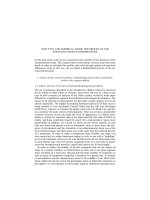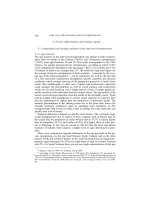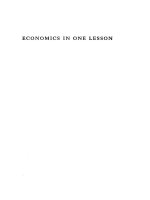Economics through everyday life from china and chili dogs to marx and marijuana
Bạn đang xem bản rút gọn của tài liệu. Xem và tải ngay bản đầy đủ của tài liệu tại đây (6.42 MB, 254 trang )
To Elaine Bensavage, Boban Rakovic, & Ed
Easterling
Copyright © 2016 by Anthony Clark.
No part of this publication may be reproduced, stored in a retrieval system, or transmitted in any
form or by any means, electronic, mechanical, photocopying, recording, scanning, or otherwise,
except as permitted under Section 107 or 108 of the 1976 US Copyright Act, without the prior
written permission of the publisher. Requests to the publisher for permission should be addressed
to the Permissions Department, Zephyros Press, 918 Parker St., Suite A-12, Berkeley, CA 94710.
Limit of Liability/Disclaimer of Warranty: The publisher and the author make no representations or
warranties with respect to the accuracy or completeness of the contents of this work and
specifically disclaim all warranties, including without limitation warranties of fitness for a particular
purpose. No warranty may be created or extended by sales or promotional materials. The
advice and strategies contained herein may not be suitable for every situation. This work is sold
with the understanding that the publisher is not engaged in rendering medical, legal, or other
professional advice or services. If professional assistance is required, the services of a
competent professional person should be sought. Neither the publisher nor the author shall be
liable for damages arising herefrom. The fact that an individual, organization, or website is
referred to in this work as a citation and/or potential source of further information does not mean
that the author or the publisher endorses the information the individual, organization, or website
may provide or recommendations they/it may make. Further, readers should be aware that
websites listed in this work may have changed or disappeared between when this work was
written and when it is read.
For general information on our other products and services or to obtain technical support, please
contact our Customer Care Department within the United States at (866) 744-2665, or outside
the United States at (510) 253-0500.
Zephyros Press publishes its books in a variety of electronic and print formats. Some content that
appears in print may not be available in electronic books, and vice versa.
TRADEMARKS: Zephyros Press and the Zephyros Press logo are trademarks or registered
trademarks of Callisto Media Inc. and/or its affiliates, in the United States and other countries,
and may not be used without written permission. All other trademarks are the property of their
respective owners. Zephyros Press is not associated with any product or vendor mentioned in
this book.
ISBN: Print 978-1-62315-668-8| eBook 978-1-62315-669-5
CONTENTS
Introduction
1 WHAT IS ECONOMICS & WHY DOES IT MATTER?
Economics Defined
Economic Resources
Schools and Subfields of Economics
2 THINKING LIKE AN ECONOMIST
Fundamental Economic Concepts
Fundamental Economic Models and Assumptions
3 FREE MARKETS VERSUS GOVERNMENT REGULATION
The Miracle of Markets
Market Failure and Market Regulation
Price Controls as an Example of Government Regulation
Government Failure
4 COMPETITION, MONOPOLIES, & ANTITRUST LAWS
Competitive Versus Noncompetitive Markets
Monopolies
Antitrust Regulation and Enforcement
5 GLOBALIZATION & THE US ECONOMY
What Is Globalization, and What Is Good about It?
Free Trade Agreements and Other Forms of Economic
Integration
Protectionism: The Flip Side of Free Trade
Possible Downsides of Globalization
The Economics of Immigration
6 UNDERSTANDING THE MACROECONOMIC NEWS
Macroeconomics and Microeconomics
Indicators of Economic Health
Monetary Policy, Fiscal Policy, and the Federal Reserve
7 BOOMS, BUBBLES, & BUSTS
The Basics of Business Cycles
What Causes Business Cycles?
Recessions and Depressions
From Boom to Bubble to Bust
The 2007–2008 Financial Crisis: Who’s to Blame?
8 THE SOCIAL SECURITY SYSTEM, WELFARE SPENDING,
& HEALTHCARE IN THE UNITED STATES
Social Security: A Ticking Time Bomb?
The Debate over Welfare Spending in the United States
Healthcare: A Market Like No Other
9 THE FUTURE OF ECONOMICS
An Evolving Science
Glossary
Biographies
Visual References
Sources
About the Author
INTRODUCTION
The financial crisis of 2007–2008 took a lot of Americans by surprise. Many people saw
their retirement savings drop rapidly in value. Business owners found it difficult to get
loans from banks. A recession followed the crisis, and many workers in a wide range of
industries lost their jobs.
The financial crisis and the ensuing events were a wake-up call for economists, who
began to ask themselves what they had missed, and for policymakers in Washington who
realized that some kind of immediate action was necessary to prevent the economy from
spiraling further downward. It was also a wake-up call for many ordinary Americans who,
perhaps for the first time in their lives, got a small taste of the kind of economic pain that
their parents, grandparents, or great-grandparents had experienced during the Great
Depression. It was as if the United States had been on autopilot, the entire nation taking
for granted that the economy would keep growing, that money would keep flowing from
the banks, and that companies would keep expanding and hiring workers.
And the financial crisis brought something else—new (or renewed) and widespread
interest in economics. Many people suddenly had lots of economic questions: Can things
get worse? Can the United States experience another Great Depression? Who is to
blame? Wall Street bankers? The Federal Reserve? The government? There were more
specific questions, too: What does the Federal Reserve do, anyway? Is there really a
problem with income inequality in America? How can we keep the Social Security
program solvent and intact for future generations?
These questions, among many others, are addressed in this book. Economics isn’t just
for academics, government policymakers, or Wall Street titans. The field actually has a lot
to offer non experts, too. When you understand economics, even at a very basic level,
you can make better economic decisions for yourself, and you can be a more informed
citizen when it comes to deciding how and when the federal government should be
involved in the economy.
With these thoughts in mind, this book has two main purposes. The first is to tell you
about the most important economic terms and principles in the clearest way possible, and
with little economic jargon, so you can develop a grasp of the important economic
concepts that every informed citizen should understand. The second is to present you
with as nonpartisan and balanced an analysis as possible of some of the most important
economic issues affecting our country today, so you’ll have the information you need to
reach your own conclusions.
CHAPTER 1
introduces some basic terms and concepts in the field of economics, and
includes a brief overview of the major schools of economic thought.
CHAPTER 2
builds on that foundation by laying out additional basic concepts and helping
you learn to see the world the way economists do.
CHAPTER 3
offers an overview of what markets are and how they’re supposed to operate.
The chapter also discusses why government intervention in markets is sometimes
needed.
CHAPTER 4
explores key concepts and issues related to competition, monopolies, and
antitrust laws.
CHAPTER 5
examines economics in the context of globalization and international trade,
while also touching on the economics of immigration.
CHAPTER 6
presents some of the basic measures that economists and policymakers use to
stay informed about the state of the economy. The chapter also covers the basics of fiscal
policy, monetary policy, and the workings of the Federal Reserve.
CHAPTER 7
discusses economic booms, bubbles, and busts, placing them in the broader
context of business cycles. The chapter also examines the financial crisis of 2007–2008.
CHAPTER 8
takes a close look at the federal Social Security program, federal welfare
programs, and the US healthcare system and how they affect the nation’s taxpayers.
CHAPTER 9
offers some parting thoughts, as well as some predictions about what the field
of economics will look like in the future, and the implications of economic research and
thought.
After you’ve read the book, don’t be surprised if you find yourself paying closer
attention to economic news. You may even decide that you’d like to learn still more about
economics. It’s true that graphs, charts, and equations can look rather complex, but
always keep a simple fact in mind: Most economic theories and concepts are simpler than
economists make them appear. It doesn’t take much to learn the essentials of economics
—and the essentials will carry you a long way.
1
WHAT IS ECONOMICS & WHY DOES IT
MATTER?
Since the 19th century, economics has borne the ignominious moniker of “the dismal
science.” Some people think economics is called “the dismal science” because it’s a dry
and difficult subject. Others think it’s because economics tackles depressing topics such
as poverty, crime, war, taxes, inflation, and economic collapse. The cheerless nickname
has been attributed by some to the Scottish historian Thomas Carlyle, who reportedly
coined the term when discussing economist Thomas Malthus’s prediction that one day
population growth would outstrip food production and cause widespread famine. It’s true
that Carlyle wrote about Malthus on occasion. But Carlyle’s negative characterization of
economics in fact appears in an article that he wrote about slavery in the West Indies,
not in any of his writings about Malthus. And, as it turns out, Carlyle delivered his insult to
economics simply because the free market economists of his time did not support his
proslavery views (see chapter 3 for a discussion of free markets). So, in the end,
economics earned its less than auspicious nickname for being on what most would agree
was the right side of history.
Thomas Carlyle, who once called economics a “dismal science,” also wrote books about the French Revolution and
Frederick the Great.
This first chapter will introduce you to a few very basic economic ideas, and will plant
the seed in your mind that economics is anything but “dismal.” You’ll learn what
economics is and what it isn’t, and you’ll learn about the fundamental problem at the
heart of every economic question. In addition, you’ll get a brief overview of the major
schools of economic thought.
ECONOMICS DEFINED
What do economists do? A simple answer is that economists practice, teach, or work to
advance the field of economics.
Every person who chooses finance or accounting as a college major is also required to
study economics, but economics isn’t the same as finance or accounting. Economics is the
framework that underlies all the business disciplines, just as physics is the framework
that underlies all the engineering disciplines.
A lot of economic work involves money, but it doesn’t have to. That’s why it would be
a mistake to say that economics is the science of money. It’s true that plenty of
economists spend their careers studying money, the money supply, and the banking
system, but a pile of money doesn’t do anything by itself. What interests an economist is
how human beings behave when they get their hands on a pile of money. In other words,
economics is about human behavior.
Economics is not the only field concerned with the study of human behavior, of course.
Psychology, sociology, and anthropology are three fields in the social sciences that also
focus on human beings and how they behave. In this respect, then, economics is more
closely aligned with those fields than with the fields of finance and accounting. We might
say that economics is the social science concerned with how people (or other decisionmaking units such as business firms or government agencies) can best allocate their
limited resources to achieve optimal or maximum satisfaction. Or, we could say that
economics deals with how people make choices in conditions of scarcity.
WHY MOST ECONOMISTS DON’T GIVE STOCK TIPS
Most investment firms have economists on staff, but an economist is not a stockbroker. In fact, many
economists refuse to give advice on investments. First, although economists are generally paid well, only a few
have struck it rich in the stock market. Second, the few economists who actually are wizards at reading and
predicting the stock market are probably not eager to reveal their secrets. But the likely main reason they don’t
offer stock tips is because economists know that, on average, an expert picking stocks for a portfolio is no more
likely to pick a winner than a monkey throwing darts at the stock pages.
Economic research supports a concept called the efficient market hypothesis, which states that it’s
impossible for anyone to pick a portfolio of stocks that beats the market. In other words, you cannot pick a
portfolio that attains a return better than the average return in the market. Why is that? It’s because all the
relevant information about any stock has already been priced into that stock, and no one has access to any
special information that would support a prediction of a particular stock’s price going up or going down. To put
this idea another way, no one can beat the market on a regular basis.
There are always exceptions to the rule, and one person who has managed to beat the market consistently is
Warren Buffet, the so-called “Wizard of Omaha.” However, in tests pitting professional brokers against stand-ins
for monkeys—that is, either computers or ordinary people picking stock portfolios—the “monkeys” typically have
done about as well as the pros, if not slightly better. (And stock-picking monkeys don’t charge fees or work for
commissions.)
Warren Buffet (left), meeting with President Obama (right) in 2010, became one of the world’s richest men as
the head of Berkshire Hathaway, a financial holdings firm.
ECONOMIC RESOURCES
Why is scarcity so important to economics? It’s because economic resources are scarce—
and that’s the problem at the heart of every economic question.
Most modern economists start from the assumption that having more material goods
is better than having fewer material goods. In making this assumption, economists are
following not only the founders of economic thought but also many economists that have
followed since, all of whom have observed that when people have a choice, they tend to
prefer having more to having less.
Thus the more-is-better paradigm is fundamental to economics, although it is
sometimes questioned and even criticized. For example, in 1973 E. F. Schumacher
published his influential book Small Is Beautiful and gave it the subtitle Economics as if
People Mattered. More recent movements—for tiny houses, or simple living—also seem to
fly in the face of this basic economic assumption.
Remember, though, that economics is about studying human behavior. When
economists observe that the typical human being has a more-is-better mind-set, they’re
not necessarily saying that it’s best for people to adopt this attitude, or that it should
permeate economics in the Western world. They’re simply drawing a conclusion derived
from hundreds of years of studying how actual human beings relate to actual material
goods.
Economic resources are generally divided into four categories: land, labor, capital, and
entrepreneurship. When economists talk about resources at the small-scale (micro) level,
they’re usually referring to the assets, or inputs, that allow a firm to produce goods and
services to be sold in the market. When economists talk about economic resources at the
large-scale (macro) level, they’re usually referring to the assets that allow a nation (or a
state or region) to produce goods and services for citizens. Let’s take a closer look at
each of these four categories of economic resources.
“Real capital,” like farm equipment or computers used to support production, is differentiated from “financial capital,” such
as cash used to pay farm workers.
•
Land is more than the ground you walk on, and it’s more than farmland. It includes
any natural asset that may be used in producing goods and services. Water, trees, oil,
and minerals all belong to the resource category of land.
•
Labor is exactly what it sounds like—workers, along with their skills and abilities. The
resource category of labor also has a connection with the term human capital, which
refers to workers’ skills, experience, and education.
•
The resource category of capital includes all goods produced in support of the productio
of other goods. Machinery (a tractor, for example), equipment (say, a computer), and
business facilities (such as the office that houses the computer) are all included in the
subcategory of real capital. Economists distinguish real capital from financial capital,
which includes assets such as stocks, bonds, and cash.
•
Over the years, entrepreneurship has come to be recognized as an additional resource
category. The role of entrepreneurs in an economy is decidedly different from the role
of workers. Entrepreneurs assemble material resources and determine production and
distribution. They are innovators who dream up new products, create new twists to
old products, and open new markets for established products. They also assume the
risk of failure inherent in any business endeavor.
The stock of economic resources is always limited. Over time, however, new resources
can be discovered or otherwise acquired. The quality of resources can also be improved.
For example, when workers receive more training (i.e., when human capital increases),
the workforce becomes more productive. When the stock of resources increases, or when
the quality of resources improves, the result is economic growth.
Whatever the source of an economy’s growth, most people would agree that a
growing economy is better than a stagnating or declining economy. That’s because tradeoffs have to be made when an economy is stagnant or, even worse, shrinking, and often
those trade-offs require tough political choices. Where should we cut spending—in the
area of healthcare or in education? Do we close this naval base or that army base? But
when the economy is growing, not only can we keep both bases open, we can also build
a brand-new Air Force base while also improving the quality of healthcare and education.
A growing economy also lowers the unemployment rate by boosting the supply of
jobs. And who doesn’t want low unemployment? At the household level, long-term
unemployment can be devastating for an individual or a family, and high unemployment
in the larger society is associated with many problems, including social unrest. That’s why
the financial media follow the unemployment rate so closely, why politicians give it so
much attention, and why economic policy—at the national level and often at the state
and local levels as well—is generally geared to boosting the economy and reducing
unemployment.
THE HEDONIC TREADMILL: WHY ENOUGH IS
NEVER ENOUGH
Every government, business, household, and individual faces some degree of scarcity, no matter how much
money is available. Not only that, but human beings who want a material good and then manage to acquire it
will also have a tendency to want more and more of it. This tendency is known as hedonic adaptation, and it
explains why some people never enjoy true happiness, no matter how rich or successful they become.
Let’s take a common example: Joe wins $10 million in a state lottery, and for a little while he’s a lot happier. But
he quickly gets used to having that much money, and soon he wants even more. In fact, he actually comes to
believe that $10 million is no longer enough to meet his needs. Joe has returned to his usual level of happiness—
what might be called his set point.
We’re all like Joe in our tendency to maintain a relatively stable level of happiness over time, even when some
positive or negative event lifts us up or knocks us down. As a result, we’re all putting in time on what
economists, stealing a term from psychologists, call the hedonic treadmill. This is why scarcity will always be a
reality for human beings, and why the field of economics matters.
SCHOOLS AND SUBFIELDS OF ECONOMICS
At any given point in history, economists have rarely been in total agreement about what
constitutes the best economic policy. Because economics is a social science, which means
that its theories can’t be tested in highly controlled laboratories, there has probably been
more disagreement among economists than among colleagues in the hard sciences. As a
result, there are numerous schools of economic thought and, economists being
economists, they can’t even agree on exactly how many schools of thought there are.
Some schools have marked similarities while some are polar opposites, but each one
constitutes a particular way of looking at the economy and economic policy.
A good place to start our discussion on schools of economic thought is the concept of
mercantilism and the system derived from that concept. The mercantilist system
dominated Europe from the 1500s to the 1700s, and it was marked by heavy government
regulation of trade. That heavy regulation had a single purpose: to strengthen the hand
of the state. Nations that took the mercantilist approach sought to export goods and
block imports. These governments also tended to hoard gold and silver. One hallmark of
the mercantilist system was colonialism, particularly when it came to plundering the
resources of colonized regions. No modern-day economist would be likely to identify as a
mercantilist, but mercantilist ideas do crop up among politicians who promote restrictions
on imports.
YOU CAN’T MAKE AN OMELETTE WITHOUT
SOMEONE TO SHIP EGGS
When Adam Smith published the famous book known today as The Wealth of Nations, he observed that people
pursuing their own economic interests inevitably promote society’s interests. He noted that, when left alone,
people would seek to maximize profit and revenue by developing efficient production and charging low prices,
thereby benefitting both the seller and the buyer. Since then, people have often cast Smith as an 18th-century
prototype of Gordon Gekko, the fictional stockbroker in the film Wall Street who said, in effect, that greed is
good. But that’s not quite what Smith meant.
Consider everything that has to happen for a carton of eggs to appear in your local supermarket. Someone has
to produce lumber and wire and ship those materials to a place where someone else can buy them to build
chicken coops. Someone has to produce chicken feed. A farmer has to raise the chickens and harvest their
eggs. Meanwhile, others have to build oil rigs so gasoline can fuel the trucks that will have to be manufactured
before the eggs can be transported to the supermarket in the carton that someone has to fabricate.
Isn’t every one of these people pursuing a personal economic interest? And isn’t every one of them also
promoting society’s interests?
But who is coordinating all this activity?
No one. It’s all occurring as if it were being guided by an unseen power. This power is what Adam Smith called
the market’s “invisible hand,” and what modern economists recognize as market forces.
Major Schools of Economic Thought
This summary doesn’t presume to cover every possible school of economic thought—
there may be dozens, thanks to economists’ tendency to split hairs. Instead, this
summary is intended to give you an idea of the breadth of economics and the nature of
its internal conversations, or discourse. Even Nobel laureates in economics sharply
disagree with one another. That’s one reason why you, as an informed citizen, should
have a basic understanding of what’s at stake in those disagreements, so that you can
listen to both sides and arrive at your own conclusions.
The Classical School
It’s generally agreed that modern economic thought began with Adam Smith and his 1776
magnum opus, An Inquiry into the Nature and Causes of the Wealth of Nations. Smith,
who was actually a philosopher—the economist profession didn’t exist during his time—
laid the foundational elements of the school of thought that has come to be known as
Classical economics. According to the Classical school, the economy operates best when
markets are mostly left to their own devices; in other words, when the government
employs a laissez-faire, or hands-off, approach. The Classical school promoted the idea
that prices (also known as the price mechanism) allocate resources efficiently, as if all
economic activity were being guided by an invisible hand. The Classical school also
advocated free trade, specialization, and the division of labor. The Classicals believed
that wide-scale unemployment was a problem that would eventually correct itself as
markets, left on their own to operate through the price mechanism, automatically moved
the economy toward full employment. Therefore, in the Classical view, there was little or
no role for the government in managing the economy. Adam Smith was the first of the
Classical economists, but he wasn’t the last. Other well-known economists associated
with the Classical school include Thomas Malthus, David Ricardo, Jean-Baptiste Say, and
John Stuart Mill.
The Marxist School
Marxism is as much a political philosophy as it is a school of economic thought. The
Communist Manifesto, published in 1848 by Karl Marx and Friedrich Engels, lays out some
of the authors’ criticisms of capitalism. It contends that capitalism will one day be
replaced by socialism and then, later on, by communism. The Marxist school focuses on
the
struggle between
the bourgeoisie (the capitalists or owners of the means of
production) and the proletariat (the working class). The labor theory of value is a major
component of Marxist economic thought. It states that the value of a good derives from
the labor required to produce it. Marx didn’t originate that idea—it actually appears in the
writings of various Classical economists—but he did appropriate it and use it as an
argument against capitalist profits. In his 1867 work Capital: Critique of Political
Economy, Marx continued his criticism of the capitalist system by arguing that it’s built
entirely upon the exploitation of labor. Marx argued for the necessity of a socialist
revolution that would establish what he called a “dictatorship of the proletariat.” The
ultimate goal, in the Marxist view, is public ownership of the means of production,
distribution, and exchange. People sometimes think of Marxist economics as being
diametrically opposed to Classical economics, and in a sense that’s true. The Classicals
advocated free markets, and Marxists favor the notion of tightly controlled markets or no
markets at all (the grand vision of communism features a utopian society without money,
and thus without trade). Clearly, the Marxist school has been influential in several places
around the world, but much less so since the fall of the former Soviet Union.
Adam Smith, the first of the Classical economists, is credited as the father of modern economic thought.
Karl Marx’s belief that workers must take ownership of the means of production inspired revolutions and labor movements
throughout the world.
The Neoclassical School
The Neoclassical school, whose ideas began to appear around 1870, built on the
propositions of Classical economics and began to focus on some of the finer details of
interactions in markets. The Neoclassical view begins with the assumption that people
are basically rational when they make decisions. Neoclassicals believe that consumers
behave rationally and attempt to maximize their utility, or satisfaction, within the limits of
their available resources. Sellers, also assumed to be acting rationally, are seen as
attempting to maximize their profits. The interaction between consumer demand and
seller supply determines market prices. The focus on comparing additional costs and
additional benefits, or marginal analysis (see here) also emerged from the Neoclassical
school. Many of the economic fundamentals taught today are Neoclassical theories and
approaches. Even the supply and demand curves prominently scrawled on college
blackboards around the world came out of the Neoclassical movement.
The Keynesian School
In some respects, it isn’t Marxism that represents the antithesis of the Classical view, but
rather the school named after John Maynard Keynes (pronounced “Kanes”). The man
behind the Keynesian school was no Marxist. He agreed with a number of basic tenets of
Classical economics, such as the importance of the price mechanism. But he also
disagreed with certain Classical ideas such as the notion that unemployment is selfcorrecting, or the belief that government has no significant role to play in correcting the
economic problems of a nation, state, or region. Rather, Keynes and his disciples believed
that government has the means, as well as the moral obligation, to counteract problems
such as unemployment and inflation through its taxing and spending policies. Keynesian
theories were first put into practice by President Franklin D. Roosevelt during the Great









